|
STUDY GUIDE
USII.2 -- Geography |
The
student will use maps, globes, photographs, pictures, and tables for
a) explaining how physical features and climate influenced the movement of
people westward;WHITE TYPE - FROM VDOE CURRICUMUM
FRAMEWORK
YELLOW TYPE - ADDITIONAL
INFORMATION FOR BETTER UNDERSTANDING |
|
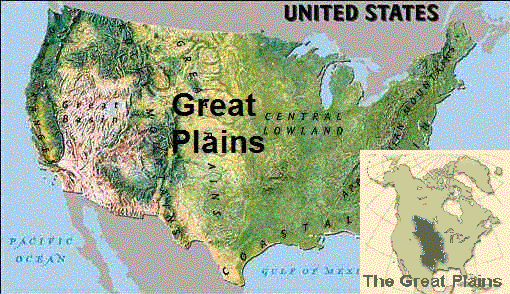
Physical features/climate of the Great Plains
• Flatlands that rise gradually from east to west
• Land eroded by wind and water -
• Low rainfall
• Frequent dust storms
How did people’s perceptions and use of the Great Plains
change after the Civil War?
1850-1890 - Before 1860, those who crossed the
Mississippi generally traveled all the way to the west coast. Few settled in
the Great Plains.
 Living
on the Great Plains presented many challenges. The winters were bitter cold.
There were few rivers and streams for water, and few trees for wood. Low
rainfall caused drought and dust storms. Fierce winds and frequent dust
storms eroded and blew away the soil. The remaining tough soil was thought
to be unsuitable for farming. Before the Civil War, the Great Plains were
considered a "treeless wasteland". Living
on the Great Plains presented many challenges. The winters were bitter cold.
There were few rivers and streams for water, and few trees for wood. Low
rainfall caused drought and dust storms. Fierce winds and frequent dust
storms eroded and blew away the soil. The remaining tough soil was thought
to be unsuitable for farming. Before the Civil War, the Great Plains were
considered a "treeless wasteland".
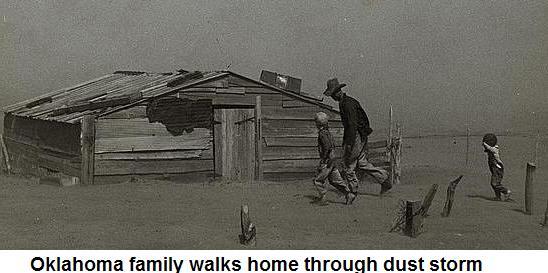
Encouraged by the Homestead Act of 1862 which gave willing
farmers land on the Great Plains, and new technologies which allowed people
to live in more challenging environments, farmers and immigrants flocked to
the Great Plains during the decades after the Civil War. People began to see
the Great Plains no as a "treeless wasteland" but as a vast area to be
settled.
How did people adapt to life in challenging
environments?
During the latter half of the 19th century, perceptions of the Great Plains
changed. Technological advancements allowed people to live in more
challenging environments. People began to perceive the Great Plains not as a
“treeless wasteland” but as a vast area to be settled.
Some of the innovations and technologies that encouraged settlement of the
Great Plains and help people adapt to the challenging environment of the
Great Plains were:
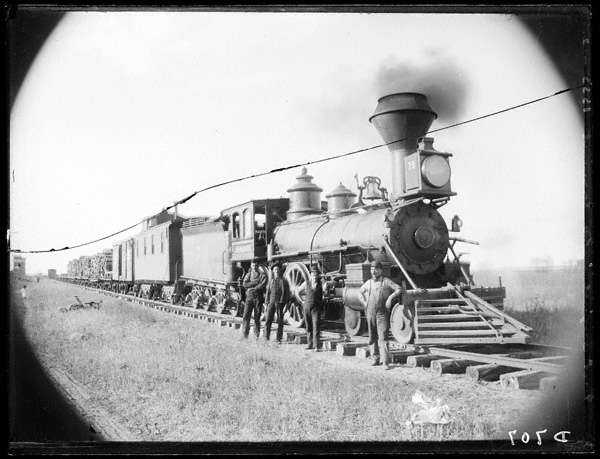 • Railroads • Railroads
1860-1890 The railroad network in
the US grew fast. The Transcontinental Railroad, completed in 1869, was made
of many different lines. It linked the Atlantic and Pacific coasts and
opened the vast interior to people who wanted to settle there. The railroad
made trade between different parts of the country easier, encouraging
industrial and economic growth.
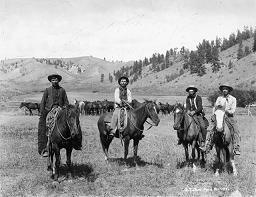 • Beef
Cattle Raising • Beef
Cattle Raising
In the early 1800s, cattle ranches began appearing on the Great Plains,
especially in Texas. Demand for beef was high, and as railroads developed,
ranchers would drive their cattle north to meet up with the lines.
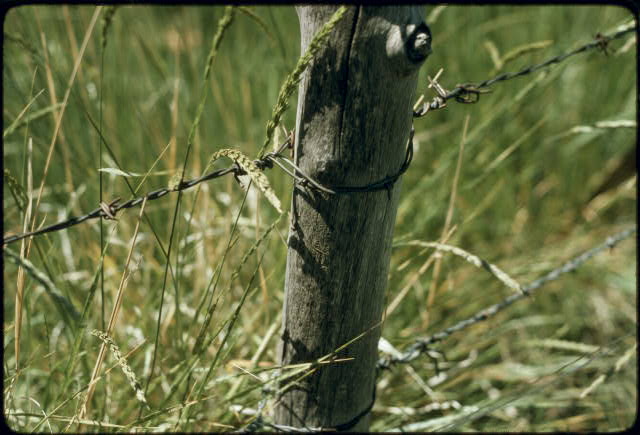  • Barbed wire • Barbed wire
The invention of barbed wire
allowed farmers to keep cattle from nearby ranches off their fields and away
from their crops.
 · •
Wheat farming · •
Wheat farming
Farmers adopted an improved strain of Russian
wheat which required less water and grew well in the dryer soil of the Great
Plains.
·
•
Steel plows
With improved steel plows, farmers could break up the tough soil.
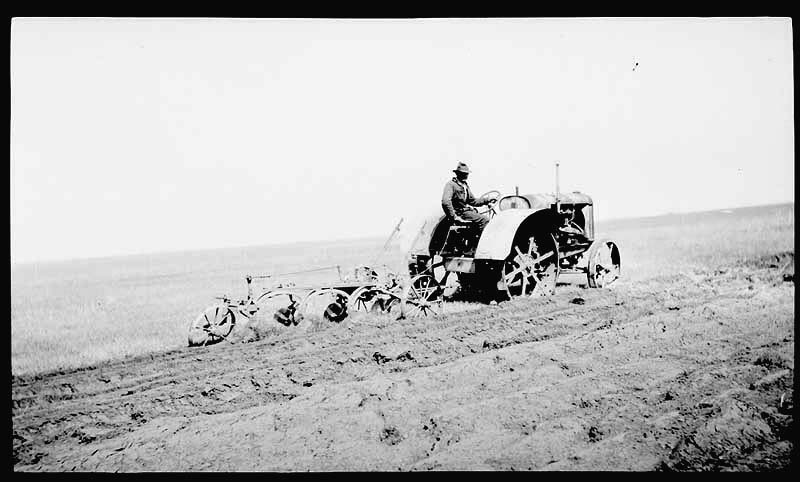
•
•Dry farming
Farmers learned they could grow crops on the dry soil if they plowed
deeply, breaking up the tough sod with the new steel plows.
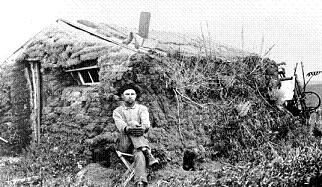 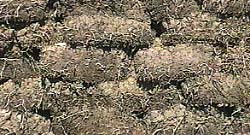 • Sod houses • Sod houses
Lacking trees
and other materials, settlers on the Great Plains built their homes from
sod, a sort of packed dirt held together by roots and cut into squares.
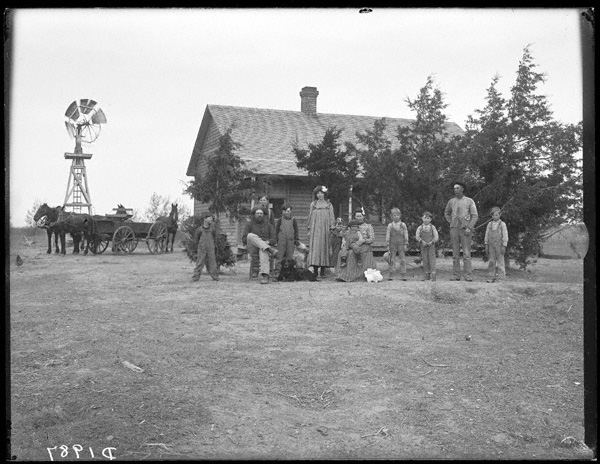
• Windmills
New models of windmills were used
throughout the Great Plains to pump water from the ground and to provide
power. |
    
CLICK on these photos to enlarge them |
The student will
use maps, globes, photographs, pictures, and tables for
b) explaining relationships among natural resources, transportation, and
industrial development after 1877. |
How did advances in
transportation link resources, products, and markets?
Advances in transportation linked resources, products, and markets.
• Transportation of resources - Railroads
- Railroads could reach interior areas, including places where an inadequate
water supply or rough terrain made canals impossible. By 1840, the United
States had almost three thousand miles of track; by 1860, a network of
thirty thousand miles linked most of the nation's major cities and towns.
• Moving natural resources (e.g., copper and lead) to eastern factories
Copper and lead mines discovered in New
Mexico, Arizona, and Utah. It was shipped by rail to eastern factories.
• Moving iron ore deposits to sites of steel mills (e.g., Pittsburgh)
In the mid-1800s, huge, easily mined deposits
of high-grade iron ore were discovered in Michigan, Minnesota, and
Wisconsin. Because iron ore could be transported more economically than
coal, the other ingredient needed for steel, iron ore was shipped by
rail to Pittsburgh. By 1860 Pittsburgh became the center for the emerging
new steel industry. The need for armaments in the Civil War gave a great
boost to the city’s iron industry.
The new Bessemer process allowed iron and coal to be converted cheaply into
steel, which was manufactured into a variety of products - from nails to
rails.
• Transporting finished products to national markets
Producers used the railroads to ship raw
materials to factories and to send manufactured goods from factories to
markets around the U.S.
What are some examples of manufacturing areas that were
located near centers of population?
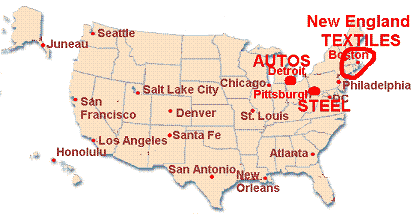
Examples of manufacturing areas clustered near centers of
population.
• Textile industry—New England
• Automobile industry—Detroit
• Steel industry—Pittsburgh
|
The student
will use maps, globes, photographs, pictures, and tables for
c) locating the 50 states and the cities most significant to the historical
development of the United States. |
Explain that states are grouped by region as follows:
·
Northeast: Maine, Vermont, New Hampshire, Connecticut,
Massachusetts, Rhode Island, New York, New Jersey, Pennsylvania
·
Southeast:
Maryland, Delaware, West Virginia, Virginia, Kentucky, Tennessee, North
Carolina, South Carolina, Georgia, Florida, Alabama, Mississippi, Louisiana,
Arkansas
·
Midwest:
Ohio, Indiana, Illinois, Michigan, Wisconsin, Minnesota,
Iowa, Missouri, Kansas, Nebraska, South Dakota, North Dakota
·
Southwest:
Texas, Oklahoma, New Mexico, Arizona
·
Rocky Mountains:
Colorado, Utah, Nevada, Montana, Wyoming, Idaho
·
Pacific:
Washington, Oregon, California
·
Noncontiguous:
Alaska, Hawaii.
|
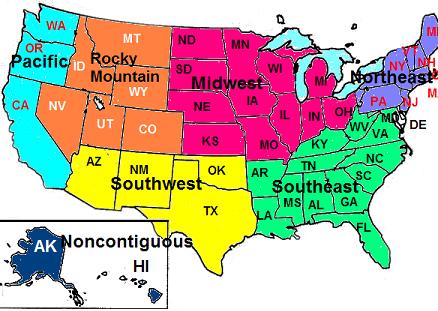 |
|
Explain how cities serve as centers of trade
and have historically had
political, economic, and cultural significance to the development of the
United States. Provide examples of cities, including the following:
·
Northeast: New York, Boston, Pittsburgh,
Philadelphia
·
Southeast: Washington, D.C.; Atlanta, New
Orleans
·
Midwest: Chicago, St. Louis, Detroit
·
Southwest: San Antonio, Santa Fe
·
Western (Rocky Mountains):
Denver, Salt Lake
City
·
Pacific: San Francisco, Los Angeles, Seattle
· Noncontiguous:
Juneau, Honolulu
|
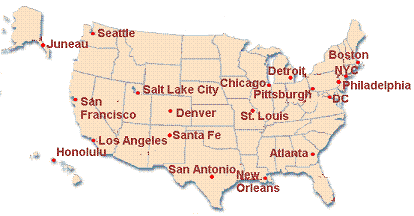 |
| Santa Fe
- Capital of New Mexico - During the 1850's, many
people headed west on the Santa Fe trail which stretched from Independence,
Missouri to Santa Fe. From Santa Fe, other trails took travelers on to
California and elsewhere. San
Antonio - Texans here staged a revolt
against Mexican rule, but were slaughtered by Mexican General Santa Anna at
the Alamo. With the battle cry "Remember the Alamo", Texans eventually
captured the Mexican dictator and Texas became an independent republic.
New York City
- By 1850, already the most populated American city. Most immigrants
arrived at Ellis Island. Many remained in NYC and many moved to other parts
of the U.S.
Pittsburgh
- Steel manufacturing center
Chicago -
Center of meat packing industry
Detroit - Center of automobile industry
MORE CITY DESCRIPTIONS TO COME! |